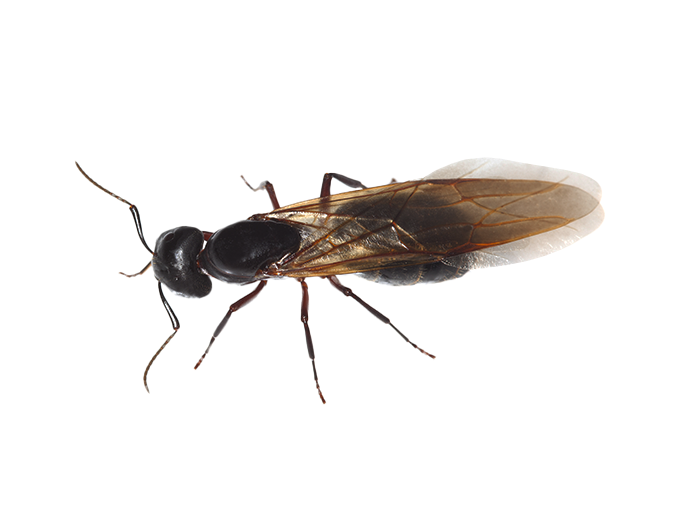If you’re finding what looks like large black ants with wings in your New Jersey home, especially near areas where water has damaged wood or where there are moisture issues, it’s probably carpenter ants. Of course, without viewing the ants ourselves or inspecting the area where activity was detected, we cannot say for certain that the problem is carpenter ants but there’s a very good chance they are.

Why these ants have wings
Typically, the carpenter ants you see crawling up and down the trees on your property or observe crawling around inside or out do not have wings. When you see winged carpenter ants, you’re looking at the reproductive members of a colony. Like flying termites who swarm every year in order to find mates and establish new colonies, carpenter ants also produce a mating swarm and will fly away from the established nest for the sole purpose of starting new carpenter ant colonies.
What do winged carpenter ants look like?
Winged carpenter ants look just like their wingless counterparts except for the fact that they have two pairs of wings – a front pair that is longer than the back pair. They have the same coloring (black, red, or yellow), have pinched waists, and elbowed antennae.
Could it be termites swarming and not carpenter ants?
There’s always that chance as both of these wood-destroying insects swarm in the spring. And unfortunately, winged termites and flying carpenter ants look very similar – at least at a distance. If you were able to compare the two up close, you’d see that termite swarmers have broad waists and straight antennae. Also, they are almost entirely black and have two pairs of wings that are the of equal size.
Where carpenter ants nest
Carpenter ants prefer to nest in wood that is moist and already damaged by water or decay but may infest dry, sound wood too. Common carpenter ant nesting sites include, but are not limited to:
- Wood siding
- Floor joists
- Door frames
- Window frames
- Wall voids
- Behind tubs, showers, and other appliances that have had plumbing issues at one point or another
- Under kitchen sinks where water has been damaged
- Voids in porch ceilings
- Hollow porch posts
- Wood that is touching soil
Carpenter ant damage
How badly carpenter ants can damage a home depends on how many nests are present inside the structure and how long they’ve been there. Large carpenter ant nests that have been active for a while are capable of causing serious and extensive damage, though typically not nearly as significant as termite damage.
What to do if you see large black ants with wings in or near your home
If you notice winged ants in or around your home, that does not necessarily mean you have a carpenter ant problem. It does warrant an investigation though. At Arrow Pest Control, we highly recommend scheduling a pest inspection to confirm or rule out carpenter ant activity, or worse, termites.
Carpenter ant control services for New Jersey homeowners
When New Jersey homeowners contact us about carpenter ants, we provide a full interior and exterior carpenter ant inspection. If we determine carpenter ants are present, we’ll locate nesting sites, and identify areas that are prone to infestation, and then go over our findings and our treatment recommendation.
How Arrow Pest Control treats carpenter ant infestations
To get rid of carpenter ants, a highly trained and fully licensed pest management specialist will:
- Apply material around the exterior perimeter of the home
- Treat key harborage areas outside
- Perform an interior carpenter ant treatment, if necessary
- Provide two follow-up services to make sure carpenter ants are exterminated
Once we’re confident the carpenter ant problem has been solved, we’ll issue a one-year renewable carpenter ant warranty. That means if carpenter ants show back up in the 365 days following the last service, we’ll come back to treat at no additional cost to you!
For greater protection against carpenter ants AND other pests, sign up for Arrow’s Home Protection Program Plus
Home Protection Program Plus
This program includes everything from the Home Protection Program – PLUS carpenter ant control and our termite monitoring advantage. Arrow will install a passive subterranean termite monitoring system at critical or conducive areas along the exterior perimeter foundation of your home. This system will include up to 4 in-ground subterranean termite monitoring stations. These stations will be serviced and inspected as part of your routine service.
Should the monitors indicate termite activity or termites occur within the home, Arrow will provide you with a termite treatment proposal at a 50% discounted rate, and you will be upgraded to Arrow Premier at the current prevailing rate.
- Is a year-round program that provides full interior and exterior service.
- Service includes a one-time interior service per year and two exterior treatments.
- Covers your entire property* including the attic, mailbox, playset, shed, and fence.
- Termite monitoring advantage
Pests targeted with Arrow’s Home Protection Program Plus includes all the pests included in the Home Protection Program PLUS carpenter ants, pharaoh ants, and acrobat ants.
*If you have a pool house that requires service, pricing would increase based upon the size of the structure.
*Termite monitoring advantage is not applicable in over-55 communities

Free Home Estimate
"*" indicates required fields

